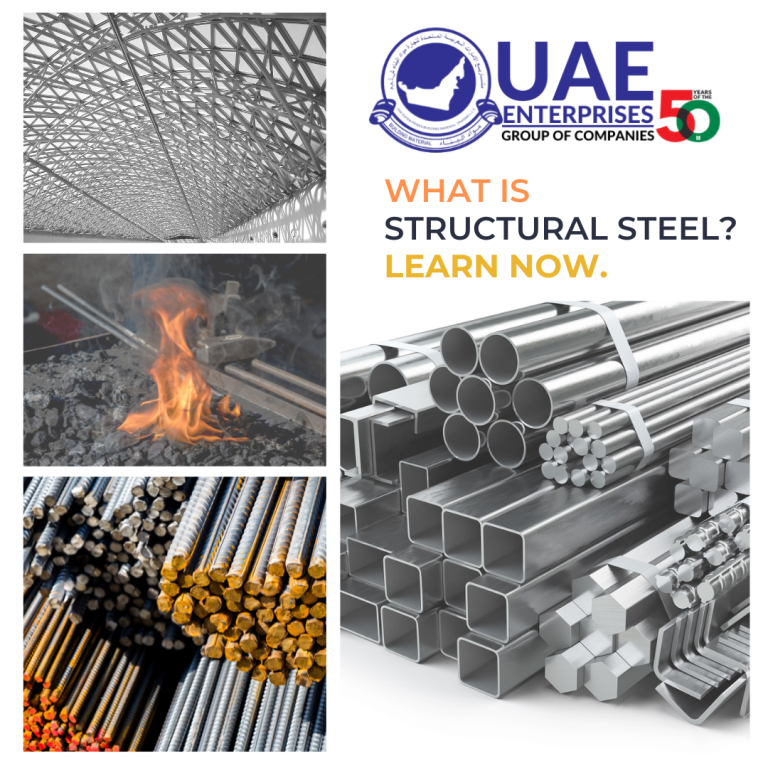Contact
Landline: (+971) 42821260
Fax: (+971) 4282 1006
(+971) 4282 7106
Email: contactus@uaeenterprises.com
Address
Head Office: - 8 Airport Rd - Garhoud - Dubai, United Arab Emirates.
Contact
Landline: (+971) 42821260
Fax: (+971) 4282 1006
(+971) 4282 7106
Email: contactus@uaeenterprises.com
Address
Head Office: - 8 Airport Rd - Garhoud - Dubai, United Arab Emirates.

Sructural steel is a category of steel used for making construction materials in a variety of shapes. Many structural steel shapes take the form of an elongated beam having a profile of a specific cross-section. Structural steel shapes, sizes, chemical composition, and mechanical properties such as strengths, storage practices, etc., are regulated by standards in most industrialized countries.
Most structural steel shapes, such as I-beams, have high second moments of area, which means they are very stiff in respect to their cross-sectional area and thus can support a high load without excessive sagging.
![]()
Structural steel roof at Manchester Victoria Station
The shapes available are described in many published standards worldwide, and a number of specialist and proprietary cross sections are also available.
While many sections are made by hot or cold rolling, others are made by welding together flat or bent plates (for example, the largest circular hollow sections are made from flat plate bent into a circle and seam-welded).[2]
The terms angle iron, channel iron, and sheet iron have been in common use since before wrought iron was replaced by steel for commercial purposes. They have lived on after the era of commercial wrought iron and are still sometimes heard today, informally, in reference to steel angle stock, channel stock, and sheet, despite that they are misnomers (compare “tin foil”, still sometimes used informally for aluminum foil). In formal writing for metalworking contexts, accurate terms like angle stock, channel stock, and sheet are used.
Most steels used throughout Europe are specified to comply with the European standard EN 10025. However, many national standards also remain in force.[citation needed]
Typical grades are described as ‘S275J2’ or ‘S355K2W’. In these examples, ‘S’ denotes structural rather than engineering steel; 275 or 355 denotes the yield strength in newtons per square millimetre or the equivalent megapascals; J2 or K2 denotes the materials toughness by reference to Charpy impact test values; and the ‘W’ denotes weathering steel. Further letters can be used to designate fine grain steel (‘N’ or ‘NL’); quenched and tempered steel (‘Q’ or ‘QL’); and thermomechanically rolled steel (‘M’ or ‘ML’).
1. S275JOH Specification S275JOH is steel grade in EN 10219 specification, EN 10210 standard. And the most widely used specification is EN10219 standard, which is Cold formed welded structural hollow sections of non-alloy and fine grain steels.
EN10219-1 specifies the technical delivery conditions for cold formed welded structural hollow sections of circular, square or rectangular forms and applies to structural hollow sections formed cold without subsequent heat treatment.
Requirements for S275JOH pipe tolerances, dimensions and sectional s275 pipe properties are contained in EN 10219-2.
2. S275JOH Steel Pipes manufacture Process
The steel manufacturing process shall be at the discretion of the steel producer. S275JOH carbon steel pipes can be made in ERW, SAW or seamless process. All S275JOH steel material and S275JOH pipes should conform to EN10219 standards.[3]
The normal yield strength grades available are 195, 235, 275, 355, 420, and 460, although some grades are more commonly used than others e.g. in the UK, almost all structural steel is grades S275 and S355. Higher grades are available in quenched and tempered material (500, 550, 620, 690, 890 and 960 – although grades above 690 receive little if any use in construction at present).
A set of Euronorms define the shape of a set of standard structural profiles:
Steels used for building construction in the US use standard alloys identified and specified by ASTM International. These steels have an alloy identification beginning with A and then two, three, or four numbers. The four-number AISI steel grades commonly used for mechanical engineering, machines, and vehicles are a completely different specification series.
The standard commonly used structural steels are:[4]
The concept of CE marking for all construction products and steel products is introduced by the Construction Products Directive (CPD). The CPD is a European Directive that ensures the free movement of all construction products within the European Union.
Because steel components are “safety critical”, CE Marking is not allowed unless the Factory Production Control (FPC) system under which they are produced has been assessed by a suitable certification body that has been approved to the European Commission.[5]
In the case of steel products such as sections, bolts and fabricated steelwork the CE Marking demonstrates that the product complies with the relevant harmonized standard.[6]
For steel structures the main harmonized standards are:
The standard that covers CE Marking of structural steelwork is EN 1090-1. The standard has come into force in late 2010. After a transition period of two years, CE Marking will become mandatory in most European Countries sometime early in 2012.[7] The official end date of the transition period is July 1, 2014.
@source @wikipedia